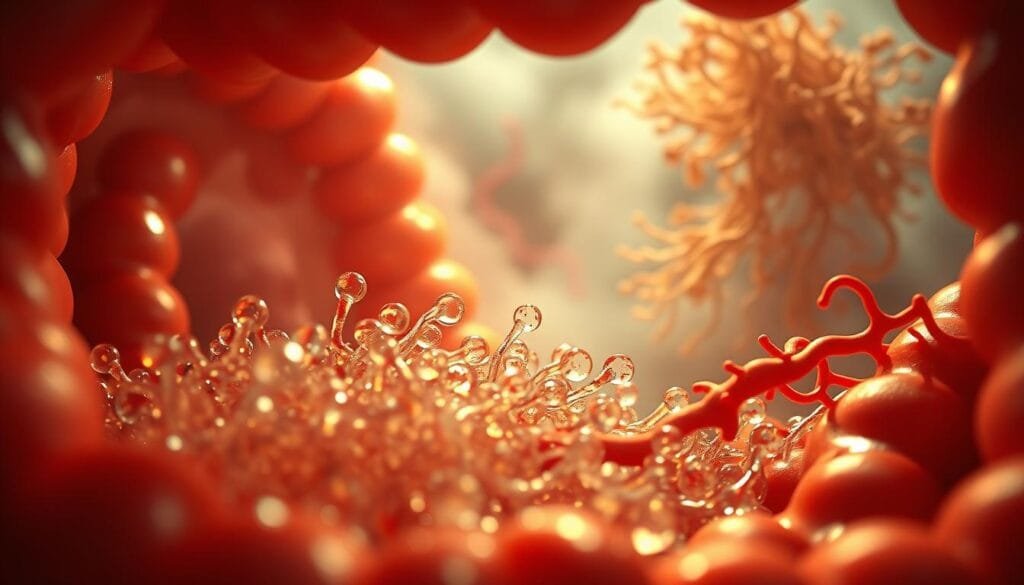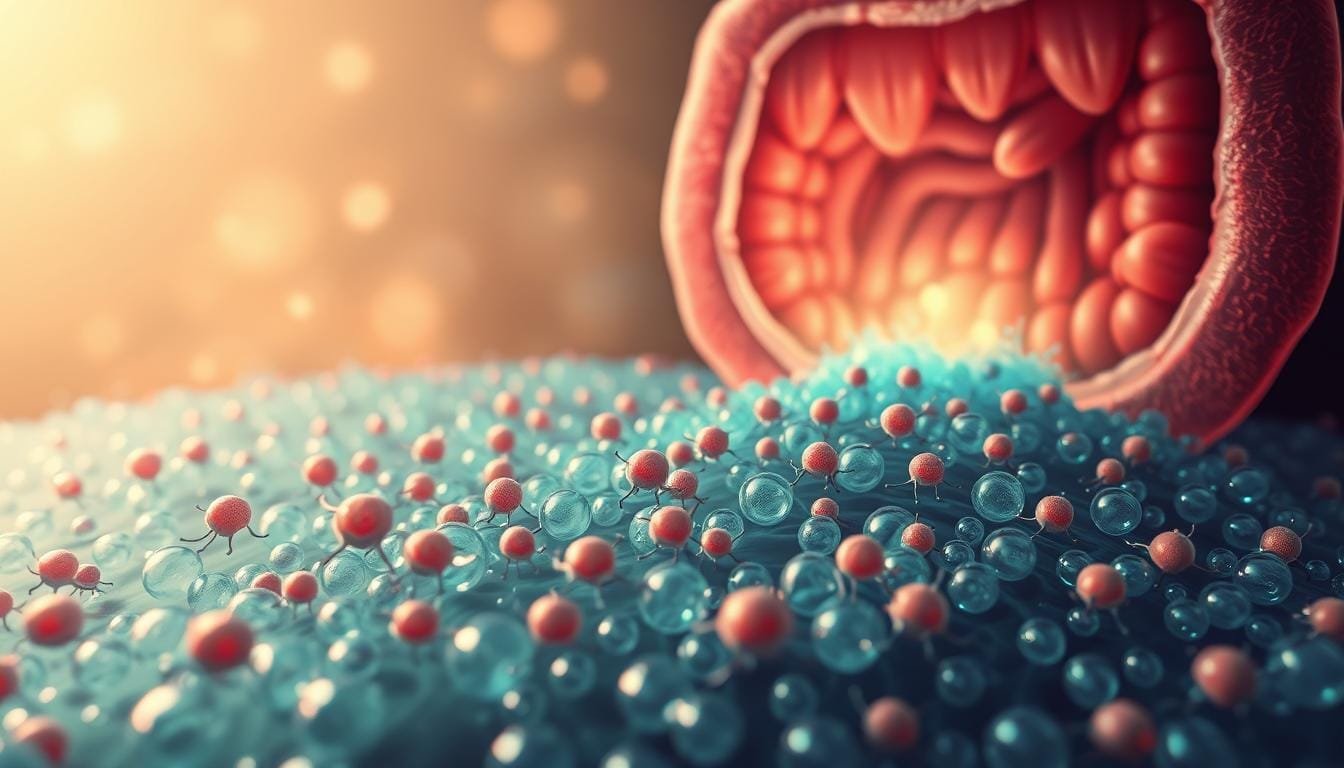Currently Empty: RM0.00
Did you know that over 70% of the immune system is linked to the stomach? This surprising fact highlights the critical role of gut health in overall well-being. But how do beneficial bacteria, often found in supplements, endure the harsh conditions of the digestive system?
This article explores whether these tiny helpers can make it through the highly acidic environment of the stomach. It delves into research findings, including a study from University College London, and examines the role of innovative protective technologies. Different strains of bacteria and their unique properties will also be discussed.
At Wellness Concept, we’re here to guide you. Reach out to us via WhatsApp at +60123822655, available Monday to Friday from 9:30 am to 6:30 pm, and weekends from 10 am to 5 pm. Our goal is to provide clear, evidence-based information to help you understand terms like “gut health” and “probiotic strain” in an accessible way.
Key Takeaways
- Over 70% of the immune system is connected to the stomach.
- Research examines how beneficial bacteria endure the digestive system.
- Innovative technologies help protect these bacteria.
- Different strains have unique properties and benefits.
- Wellness Concept offers expert guidance and support.
Introduction to Probiotic Survival
The journey of beneficial bacteria through the digestive system is fascinating. These live microorganisms, often found in foods or supplements, play a crucial role in maintaining a healthy gut. Their ability to thrive in the body’s acidic environment determines their effectiveness.

Understanding Probiotics and Their Health Benefits
Probiotics are live cultures that support the body in various ways. They help balance the gut microbiome, which is essential for digestion and immunity. Research shows they can also influence mental health, making them a key part of overall wellness.
Different strains offer unique benefits. For example, Lactobacillus rhamnosus GG is known for its resilience, while Bifidobacterium lactis supports immune function. Choosing the right strain can maximize their impact.
About Wellness Concept and Contact Information
At Wellness Concept, we provide expert guidance on gut health and probiotic use. Our team is available via WhatsApp at +60123822655, Monday to Friday from 9:30 am to 6:30 pm, and weekends from 10 am to 5 pm. We’re here to help you make informed decisions about your health.
| Strain | Key Benefit |
|---|---|
| Lactobacillus rhamnosus GG | Resilience in acidic environments |
| Bifidobacterium lactis | Immune system support |
| Lactobacillus casei Shirota | Digestive health improvement |
For more insights on probiotics and their role in managing stomach conditions, visit our detailed guide.
Do probiotics survive stomach acid
The digestive system poses a unique challenge for beneficial bacteria. The highly acidic environment, with a pH as low as 1.5-2.5, can significantly impact their viability. Understanding how these live cultures endure such conditions is essential for maximizing their health benefits.

Impact of Stomach Acid on Probiotic Viability
Stomach acid plays a critical role in breaking down food, but it can also harm beneficial bacteria. Research shows that many strains struggle to survive in such an acidic environment. For example, Lactobacillus acidophilus Rosell-52 has demonstrated remarkable resilience, making it a popular choice for supplements.
“The survival of probiotics in the stomach depends on their ability to withstand low pH levels and other digestive enzymes.”
Studies reveal that the presence of food can enhance bacterial survival. Taking supplements with meals, especially breakfast, provides a protective barrier against stomach acid. This simple adjustment can significantly improve their efficacy.
Factors Affecting the Survival of Probiotic Strains
Several factors influence whether beneficial bacteria reach the gut alive. These include:
- pH Levels: Strains like Lactobacillus gasseri thrive in low pH environments, while others may not.
- Protective Coatings: Advanced technologies, such as microencapsulation, shield bacteria from harsh conditions.
- Timing: Consuming supplements with food increases their chances of survival.
For instance, Lactobacillus rhamnosus GG shows improved viability when exposed to glucose in simulated gastric juice. This highlights the importance of selecting the right strain and formulation for optimal results.
| Strain | Survival Rate in Acidic Conditions |
|---|---|
| Lactobacillus acidophilus Rosell-52 | High |
| Lactobacillus gasseri ATCC 33323 | Moderate |
| Bifidobacterium lactis | Low |
For more insights on how to support your gut health, visit our detailed guide.
Probiotic Resilience: Strains and Advanced Technologies
Not all strains of beneficial bacteria are created equal when it comes to surviving the digestive tract. Their ability to endure harsh conditions determines their effectiveness in supporting gut health. This section explores how specific strains and modern innovations work together to enhance their survival.
Strain-Specific Survival Capabilities
Certain strains naturally thrive in acidic environments. For example, Lactobacillus acidophilus Rosell-52 is known for its high resilience. Similarly, Bacillus coagulans can withstand extreme conditions, making it a popular choice for supplements.
Research shows that these strains maintain their viability even in low pH levels. This natural resilience ensures they reach the gut alive, where they can provide maximum health benefits.
Innovative Protective Coatings and Timed-Release Technologies
Advanced technologies like enteric coatings and timed-release capsules offer additional protection. Enteric coatings shield bacteria from stomach acid, ensuring they pass through unharmed. Timed-release capsules, such as Bio-tract®, gradually release bacteria, improving their survival rates.
“The combination of resilient strains and protective technologies significantly enhances probiotic efficacy.”
These innovations work in harmony with naturally acid-resistant strains. For instance, Lactobacillus rhamnosus GG shows improved viability when combined with protective coatings. This synergy ensures that more bacteria reach the intestines, where they can support the microbiome.
Choosing the right supplement involves understanding both the strain and the delivery technology. For more insights on how to optimize probiotic intake, visit our detailed guide.
Optimizing Probiotic Intake for Maximum Efficacy
Maximizing the benefits of beneficial bacteria requires strategic timing and dosage. Proper intake ensures these live cultures reach the gut alive, where they can provide the most health benefits. This section offers practical advice on how to optimize your routine for better results.
Best Practices for Timing and Dosage
Timing plays a crucial role in the survival of these microorganisms. Taking them 30 minutes before a meal or with breakfast can improve their chances of reaching the intestines. Food acts as a protective barrier against the harsh stomach acid, enhancing their viability.
Adhering to the recommended dosage is equally important. Studies suggest that a minimum of 1 billion colony-forming units (CFUs) is necessary for noticeable effects. High-quality probiotic supplements often specify CFU counts, ensuring you receive the intended health benefit.
“Consistent intake and proper timing are essential for maximizing the efficacy of probiotic supplements.”
Here are some practical steps to follow:
- Take supplements with meals, especially breakfast, to improve survival rates.
- Choose products with clinically tested strains like Lactobacillus rhamnosus GG or Bifidobacterium lactis.
- Follow the recommended dosage to ensure adequate CFU intake.
Pairing supplements with the right foods can also make a difference. For example, oatmeal or low-fat milk has been shown to enhance bacterial survival compared to water or juice. This simple adjustment can significantly boost their effectiveness.
| Timing | Effect on Survival |
|---|---|
| 30 minutes before a meal | High |
| With breakfast | Moderate |
| On an empty stomach | Low |
For more insights on how to support your gut health, visit our detailed guide.
Conclusion
Understanding how beneficial bacteria endure the digestive process is key to their effectiveness. Research highlights that certain strains, like Lactobacillus acidophilus Rosell-52, naturally thrive in harsh environments. Advanced technologies, such as enteric coatings, further enhance their survival, ensuring they reach the gut alive.
Selecting the right supplement involves considering both the strain and its delivery method. Proper timing and dosage also play a crucial role in maximizing health benefits. For instance, taking supplements with meals can significantly improve their efficacy.
Ongoing research continues to validate the positive impacts of properly formulated products. For personalized advice, contact Wellness Concept at +60123822655. Understanding the science behind these beneficial bacteria is essential for achieving better overall health and gut balance.
FAQ
Can beneficial bacteria withstand the harsh environment of the digestive system?
Yes, certain strains are designed to endure the acidic conditions of the digestive tract, ensuring they reach the gut alive to provide health benefits.
What factors influence the viability of these microorganisms?
Factors include the specific strain, the presence of protective coatings, and the timing of consumption relative to meals.
How do advanced technologies enhance the survival of these microorganisms?
Innovations like timed-release capsules and protective coatings help shield the bacteria from stomach acid, improving their chances of reaching the intestine intact.
When is the best time to take these supplements for optimal results?
Taking them with or just before a meal can help buffer the acidic environment, increasing their survival rate and efficacy.
Are all strains equally effective in surviving the journey through the digestive system?
No, some strains have naturally higher resilience, while others may require technological assistance to ensure they reach the gut alive.



